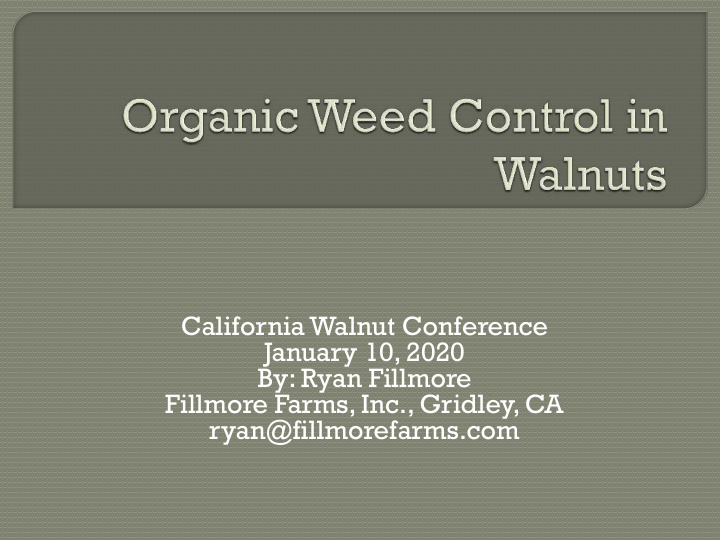



California Walnut Conference January 10, 2020 By: Ryan Fillmore Fillmore Farms, Inc., Gridley, CA ryan@fillmorefarms.com
Organic harvest nightmare if left untreated (micro-emitters)
Organic orchard (micro-emitter irrigation)
Conventional orchard with strong cover crop and strip sprayed berms
Organic orchard with berms mowed (flood irrigation)
1. Animal 2. Heat 3. Chemical 4. Mechanical
ADVANTAGES DISADVANTAGES Broad spectrum – can’t target Eco-friendly a specific portion of the Relatively low labor cost orchard (i.e. berms) Potential nitrogen source Usually requires fencing and alternate storage locations Secondary income source when not in active use Poop • Timing restricted – spring clearing only – must be > 90 days from harvest • FSMA language strongly against having livestock in orchard • Can NOT be used for harvest preparation
ADVANTAGES DISADVANTAGES Prevents weeds from Efficacy highly dependent growing on weed variety and age Targetable (berm, floor, Field and surroundings etc.) must be at minimum Moderately expensive moisture level to prevent fire Less useful for harvest prep
ADVANTAGES DISADVANTAGES Targeted application Efficacy (berm, floor, etc.) • Contact, not systemic Broad timeframe for use • No pre-emergent Similarity to conventional • Not as strong as contact weed control conventional options systems Cost
ADVANTAGES DISADVANTAGES Broad useful timeframe Timing is still important, Can clean up after other but not as critical methods Labor and energy input Equipment readily higher for 5-6 passes per available if not currently year (for optimal biomass owned reduction) Useful for flood and solid Does not currently work set irrigation well with drip irrigation implementations Can result in an adequately systems unless drip lines clean floor and berm for are in canopy harvest
Organic orchard – flood irrigation with berms
Organic orchard using disking for weed control (flood irrigation with berms)
Transitional orchard using tillage and flood/furrow irrigation (mid-summer)
Organic orchard (solid set sprinkler irrigation – flat berm)
Pak Flail mower with Sidecutter attachment and bump wheel modification
Pak Flail mower with Sidecutter attachment and bump wheel modification
Organic Orchard on September 20
Organic orchard after mowing with Sidecutter September 25 (5 days later!)
Nuts shaken and sweeping started – 2+ weeks after last mowing
Sweeping – 1 st pass – grass less of an issue for sweeping than blowing
Final windrow – Note organic matter in windrow makes it larger than conventional windrows. More frequent mowing and high earthworm population help with digestion of grass clippings over the summer prior to harvest
Pak Flail mower with Sidecutter attachment and bump wheel modification Example 2
Organic orchard during spring mow-down (flood irrigation)
Organic weed control is possible, just more difficult and/or expensive Mowing or tillage provide superior control, but timing can make a big difference with harvest difficulty or ease Chemical, animal or heat treatments can be useful, but are more limited Flood or sprinkler applications are preferred but drip is possible
Ryan Fillmore VP Operations, Fillmore Farms, Inc. ryan@fillmorefarms.com www.fillmorefarms.com
Recommend
More recommend